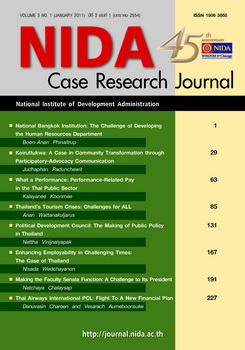Thai Airways International PCL: Flight to A New Financial Plan
Keywords:
Thai Airways, Financial Plan, Airline CompetitionAbstract
“We want to become a five-star airline, not four-star as is currently the case. Sometimes we have lapsed into trying to compete with low-cost airlines but it's time to go back up where we belong.”Dr. Piyasvasti Amranand, President of Thai Airways International PCL, April 28, 2010.
Shortly after the Annual General Meeting of the Shareholders of Thai Airways International Public Company Limited (THAI) on April 28, 2010, Mr. Daniel Castillo (Hypothetical name), Corporate Financial Manager, was charged by the President, Dr. Piyasvasti Amranand, with the preparation of a financial plan with which to fulfill the commitments that the President had just made to the shareholders. The meeting had been a contentious one, with the majority of shareholders having expressed great dissatisfaction with the report on the Company’s performance during the year 2009. In particular, shareholders were highly critical of the Company’s high debt-equity ratio, its loss of market share, and its low dividend payout ratios. They had been insistent in their call for prompt action by the President and management team to improve the airline’s performance.
In response to the shareholders, the President had stated that he had already devised the broad contours of a plan to enhance the airline’s financial position and business performance. He had then proceeded to set forth a tripartite plan that consisted of (a) improved control of expenses through the establishment of a Fuel Hedging Policy to increase the profit margin, (b) a reduction of the debt-to-equity ratio from 4 to 2 in order to strengthen the Company’s financial position, and (c) significant investments in aircraft to expand the business and increase capacity. To pursue the plan, the President and management team had placed before the shareholders a proposal that the Company be allowed to issue up to 1,000 million shares (par value = 10 Baht per share) over the course of the third quarter of the year 2010. The shareholders had approved.
With the President’s May 1, 2010 assignment of the financing plan task to the Financial Manager, the ball was now in Mr. Castillo’s court. He had to devise a comprehensive and detailed financing plan that would enable the President’s financial position and business performance objectives to be attained. In addition to the inclusion of equity issuance and a capital restructuring components, the plan was to incorporate an evaluation of the financial improvements anticipated from its implementation (e.g., a comparison of current and forecasted financial performance).
Time was very much of the essence, in that the President had requested the plan be completed in time for Mr. Castillo to present it to the President and management team at the next scheduled meeting on May 10, 2010. Mr. Castillo knew that he had to get started right away.
As he began to pull together his preliminary thoughts about the financing plan, the President’s statement to the recently concluded shareholders meeting echoed in his mind: “The [new shares] offering is an integral part of THAI's commitment to pursue its long-term growth strategy and to maximize shareholder value.” This assertion struck Mr. Castillo as an appropriate point of departure for the task before him.
Downloads
How to Cite
Charoen, D., & Aumeboonsuke, V. (2014). Thai Airways International PCL: Flight to A New Financial Plan. NIDA Case Research Journal, 3(1), 227–293. retrieved from https://so04.tci-thaijo.org/index.php/NCRJ/article/view/25076
Issue
Section
Case Study





